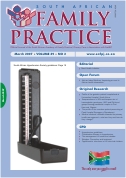Profile of the Geriatric patients hospitalised at Universitas hospital, South Africa
Keywords:
profile, geriatric patients, hospitalised, South Africa
Abstract
Background: The elderly population in Africa is unevenly distributed across the continent, with the highest percentage of elderly living in the Southern African region. In 1996, the elderly population of South Africa (65 years and older) was roughly 6.7%, and was calculated to be 10.4% by 2025. If the latter expectation is anywhere near realistic, it stands to reason that the Department of Health should make timely provision for the care of these future patients, as the prevailing disease patterns within a population change as that population ages. Thus, there is an urgent need for profiles of elderly patients in order for adequate training to be implemented and for beds and equipment to be ready when needed. Methods: A retrospective study was undertaken of all data available from a clinical audit done at Universitas Hospital’s Geriatric Unit. All patients aged 65 years and older who were admitted by Internal Medicine’s Geriatric Unit over four years were analysed in order to compile a profile of geriatric patients hospitalised at Universitas Hospital. Results: The study group consisted of 791 elderly patients. Their average age was 81 years (range: 65 to 101 years of age) and they were hospitalised for an average of 11 days, with an average use of five medications per patient. Women represented 66% of the patients and the mortality rate was 17% in the total study group. The main admitting clinical problems were hypertension, heart failure, ischemic heart disease and anaemia. Most of the patients did not smoke or use alcohol. Out of a group of 523(due to the fact that it was a retrospective study, data for this criteria were only available for 523 of the 791 patients), 235 (45%) were self-supporting and 32% were known to use living aids. The majority of the patients were single and an equal amount were living in old age homes and with their families. The main special examinations used in their treatment were chest X-rays, nuclear examinations of the liver, ECG, heart sonar and CT of the brain, and gastroscopies. Almost all of the patients had undergone full blood count analysis and U+E determinations, and in more than 50% of cases, creatine, albumin and glucose measurements were taken. Conclusion: For successful geriatric care at Universitas Hospital there will be a need for at least 11 days hospitalisation, and a unit with good training in internal medicine, psychiatry, urology, orthopaedy and oncology. The main supporting services will be physiotherapy, occupational therapy and social welfare. Laboratory analyses will include full blood count, urea and electrolyte measurements, urine examination, and creatine and glucose measurements. Special investigations will mainly be radiology and cardiology sonar examination. How well we care for elderly patients in the future will be an indicator of the quality of our healthcare system in general. We need to redesign our social insurance and welfare systems to fit the realities of our current situation.
Published
2007-02-26
Section
Original Research
By submitting manuscripts to SAFP, authors of original articles are assigning copyright to the South African Academy of Family Physicians. Copyright of review articles are assigned to the Publisher, Medpharm Publications (Pty) Ltd, unless otherwise specified. Authors may use their own work after publication without written permission, provided they acknowledge the original source. Individuals and academic institutions may freely copy and distribute articles published in SAFP for educational and research purposes without obtaining permission.

